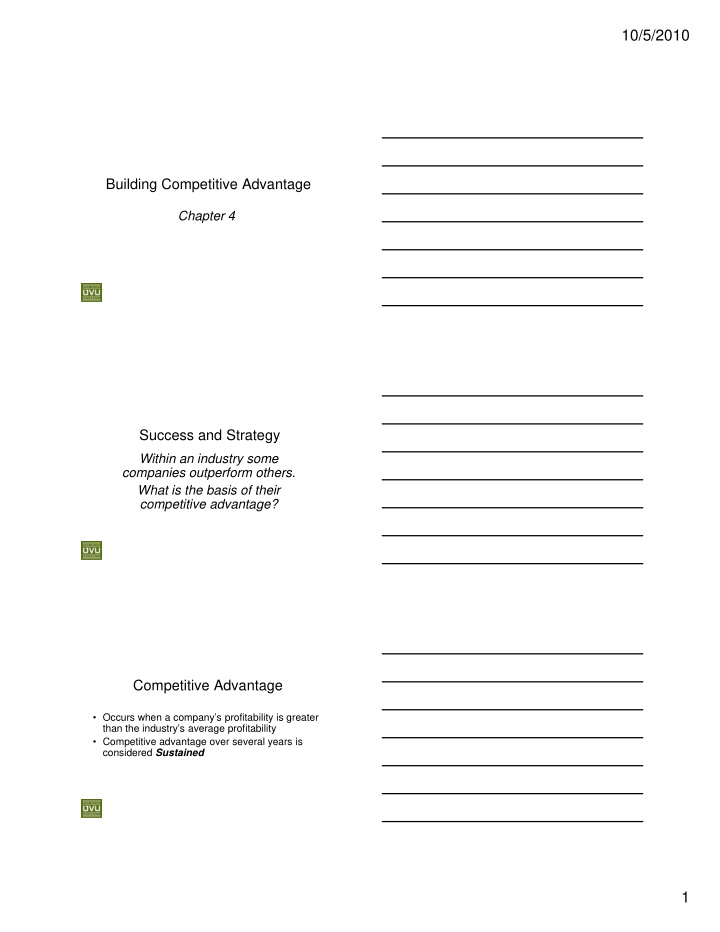



10/5/2010 Building Competitive Advantage Chapter 4 4 | 1 Success and Strategy Within an industry some companies outperform others. What is the basis of their competitive advantage? 4 | 3 Competitive Advantage • Occurs when a company’s profitability is greater than the industry’s average profitability • Competitive advantage over several years is considered Sustained 4 | 4 1
10/5/2010 Company Profitability Two basic conditions: 1.Amount of Value that customers place on a good or service – Value creation is at the heart of competitive advantage g – The greater the value customers place on a product, the more the company can charge. – A product’s price is usually less than the value placed on it by the average customer. – This causes customers to capture consumer surplus. 4 | 5 Company Profitability (cont’d) 2. The company’s cost of production – A company will look for ways to increase productivity of capital and labor through: • Economies of Scale • Spread fixed cost over large product volume • Greater division of labor and specialization G t di i i f l b d i li ti 4 | 6 Two Basic Strategies for Creating Value • Low Cost- Drive down cost structure Low Cost Drive down cost structure • Differentiation- Consumers value the product and are willing to pay a premium price 4 | 7 2
10/5/2010 Value Creation 4 | 8 Building Competitive Advantage Four Factors: 1. Efficiency 2. Quality 3. Innovation 4. Customer Responsiveness 4. Customer Responsiveness These are the generic building blocks of competitive advantage that any company in any industry can adopt. 4 | 9 Resource-Based View of Competitive Advantage… …suggests that competitive advantage is attained through firm resources that are: – Valuable - they enable a firm to implement strategies that improve its efficiency and effectiveness – Rare - not available to other competitors Rare not available to other competitors – Imperfectly imitable - not easily implemented by others – Non-substitutable - not able to be replaced by some other non-rare resource 4 | 10 3
10/5/2010 Comparing Toyota and General Motors 4 | 11 Building Blocks of Competitive Advantage 4 | 12 Efficiency • Efficiency = outputs/inputs • Employee Productivity: output per employee • Capital Productivity: Output per unit of investment capital • High Productivity = greater efficiency and low High Productivity = greater efficiency and low costs 4 | 13 4
10/5/2010 Quality (as Excellence) • Superior Quality: customers perceive attributes of a product to be better than rival’s attributes, in: – Design, – Style, y , – Aesthetic appeal, – Features and functions, and / or – Level of service that comes with the product • Excellence: when excellence is built into product offering, consumers have to pay more to own or consume the product 4 | 14 A Quality Map for Automobiles 4 | 15 Quality (as Reliability) • A product is reliable if it: – Consistently does the job it was designed for – Does the job well – Rarely, if ever, breaks down • Less time is spent of defective products and Less time is spent of defective products and fixing mistakes • Reliability increases the value a consumer gets from the product and increases the price that the company can charge 4 | 16 5
10/5/2010 Innovation • The act of creating new products or processes – Innovations give a company something unique that their competitors lack – In the long run, innovation is perhaps the most important part of competitive advantage • Product Innovation- The development of products that are new to the world or have superior attributes to existing products. • Process Innovation-The development of a new process for producing products and delivering them. 4 | 17 Customer Responsiveness • If a customer’s need is satisfied better by a certain product, the customer will attribute more value to the product. – What’s involved with making this phenomenon What s involved with making this phenomenon happen? – What risks are there to this? • More attributed value creates a differentiation and ultimately a competitive advantage 4 | 18 The Value Chain is the idea… …that a company is a chain of activities for transforming inputs into outputs that customers value • Consists of primary and support activities 6
10/5/2010 Strategy, Resources, Capabilities, and Competencies 4 | 23 Functional Level Strategies (really tactics) • Managers pursue improvement in business functions by: – Increasing efficiency – Increasing quality – Increasing innovation g – Achieving superior customer responsiveness 4 | 24 Distinctive Competencies • A unique firm-specific strength that allows a company to better differentiate or achieve lower cost than rivals • These arise from Resources and Capabilities 4 | 25 7
10/5/2010 Resources • Financial, physical, social or human, technological, and organizational factors that create value to customers. • Can be Tangible or Intangible Example: Example: Tangible = land, building, equipment Intangible = brand names, reputations 4 | 26 Capabilities • A company’s skills at coordinating its resources and putting them into productive use. • Capacities are needed to utilize resources 4 | 27 Durability • When a company has superior profitability, other companies are inclined to imitate the successful strategy. • Durability of competitive advantage depends on the ease or difficulty to copy distinctive the ease or difficulty to copy distinctive competencies. • Barriers of Imitation are the factors that make copying difficult for competitors. • Even if a company’s distinctive competencies are protected by higher barriers to imitation, it should act as if rivals are continually trying to nullify its source of advantage 4 | 28 8
Recommend
More recommend